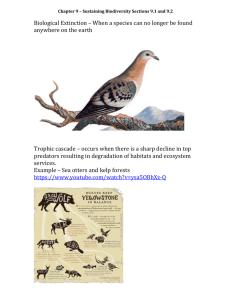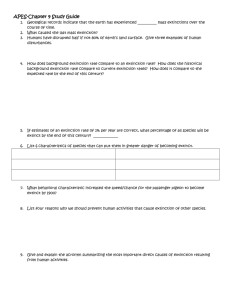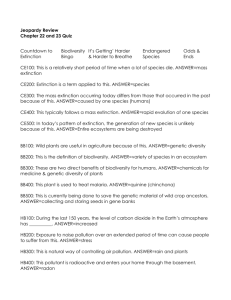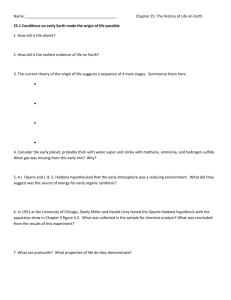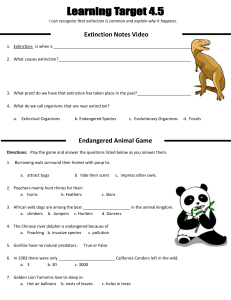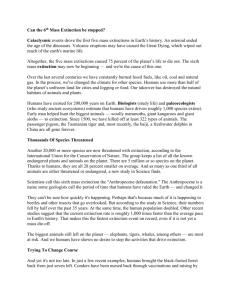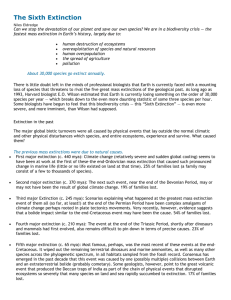MP 7
advertisement
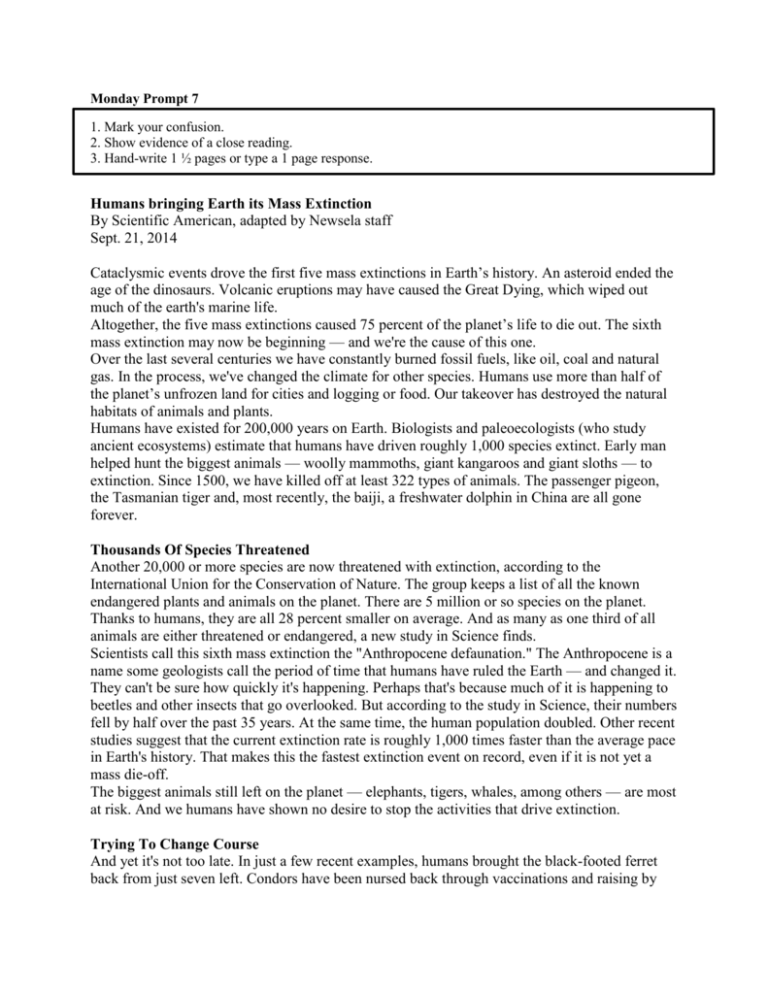
Monday Prompt 7 1. Mark your confusion. 2. Show evidence of a close reading. 3. Hand-write 1 ½ pages or type a 1 page response. Humans bringing Earth its Mass Extinction By Scientific American, adapted by Newsela staff Sept. 21, 2014 Cataclysmic events drove the first five mass extinctions in Earth’s history. An asteroid ended the age of the dinosaurs. Volcanic eruptions may have caused the Great Dying, which wiped out much of the earth's marine life. Altogether, the five mass extinctions caused 75 percent of the planet’s life to die out. The sixth mass extinction may now be beginning — and we're the cause of this one. Over the last several centuries we have constantly burned fossil fuels, like oil, coal and natural gas. In the process, we've changed the climate for other species. Humans use more than half of the planet’s unfrozen land for cities and logging or food. Our takeover has destroyed the natural habitats of animals and plants. Humans have existed for 200,000 years on Earth. Biologists and paleoecologists (who study ancient ecosystems) estimate that humans have driven roughly 1,000 species extinct. Early man helped hunt the biggest animals — woolly mammoths, giant kangaroos and giant sloths — to extinction. Since 1500, we have killed off at least 322 types of animals. The passenger pigeon, the Tasmanian tiger and, most recently, the baiji, a freshwater dolphin in China are all gone forever. Thousands Of Species Threatened Another 20,000 or more species are now threatened with extinction, according to the International Union for the Conservation of Nature. The group keeps a list of all the known endangered plants and animals on the planet. There are 5 million or so species on the planet. Thanks to humans, they are all 28 percent smaller on average. And as many as one third of all animals are either threatened or endangered, a new study in Science finds. Scientists call this sixth mass extinction the "Anthropocene defaunation." The Anthropocene is a name some geologists call the period of time that humans have ruled the Earth — and changed it. They can't be sure how quickly it's happening. Perhaps that's because much of it is happening to beetles and other insects that go overlooked. But according to the study in Science, their numbers fell by half over the past 35 years. At the same time, the human population doubled. Other recent studies suggest that the current extinction rate is roughly 1,000 times faster than the average pace in Earth's history. That makes this the fastest extinction event on record, even if it is not yet a mass die-off. The biggest animals still left on the planet — elephants, tigers, whales, among others — are most at risk. And we humans have shown no desire to stop the activities that drive extinction. Trying To Change Course And yet it's not too late. In just a few recent examples, humans brought the black-footed ferret back from just seven left. Condors have been nursed back through vaccinations and raising by hand. Salamanders have been restored. According to another new study in Science, people have physically moved 424 species of plants and animals to protect them from extinction. For such efforts to succeed, careful attention must be paid both to genetics and habitat. There is no point in bringing back the baiji dolphin, for example, if the Yangtze River in China remains polluted and overfished. But conservation efforts can work. Fishes can bounce back when we stop overfishing. Both the Maine haddock and Washington state coho salmon have. The reforesting of the East Coast of the U.S. shows that when farms go away, woodlands return. Then coyotes, deer, turkey and other wildlife move back in. The animals and plants of the Amazon rain forest have benefited from Brazil's efforts to stop deforestation. And amazingly, paleoecologists have shown that 20 out of 21 large mammals in India — from leopards to muntjac deer — have survived there for the past 100,000 years. All that time, they've lived alongside one of the largest human populations on the planet. Not Doomed Yet To avoid the sixth mass extinction we will probably have to push harder for conservation. Endangered species may need to be moved to help them deal with a changing climate. Think rewilding: reintroducing species like wolves or beavers that were once in a certain ecosystem but have since disappeared. Aggressive conservation might also mean killing off newcomer species to preserve or make room for local plants and animals; in New Zealand, killing off local rats have helped kakapo parrots survive. In the most extreme case new animals could be brought in. They could fill the role of animals that have gone extinct. For example, European sailors ate their way through the Indian Ocean islands of Mauritius, killing off the dodo bird and the local tortoise species. But tortoises from the neighboring Seychelles archipelago have been imported recently. They have helped restore the island ecosystem, including bringing back endangered local trees. There is even some hope of bringing back entirely extinct species in the future using advances in genetics and synthetic biology. Bringing back extinct species, or replacing extinct animals with similar ones to restore ecosystems, could pose problems. Right now, new invasive species are hurting ecosystems, like the Asian carp invading lakes in the U.S. We'll have to be careful. But we are not doomed to cause a sixth mass extinction, at least not yet. Based on an estimate published in Nature in 2011, we have a century or two before our actions assure a mass extinction. Unlike an asteroid, we could choose to change course. Possible Response Questions: What do you think is the greatest cause of pollution on Earth? Why is the dying of species such an issue? Do you believe humans are doing anything to prevent these things from happening?
